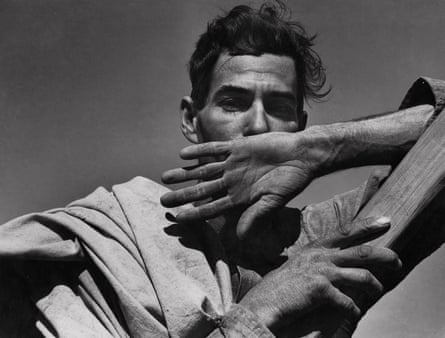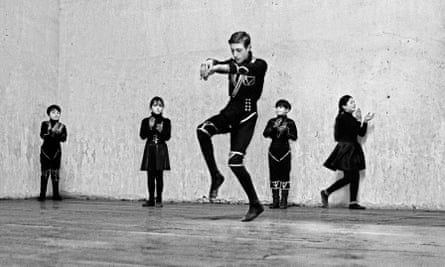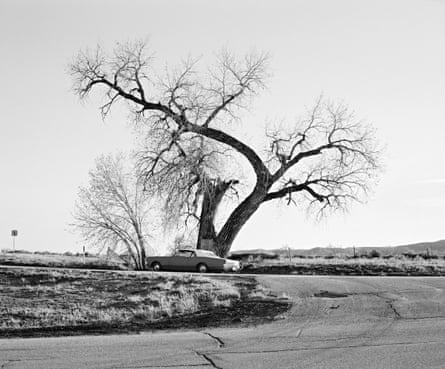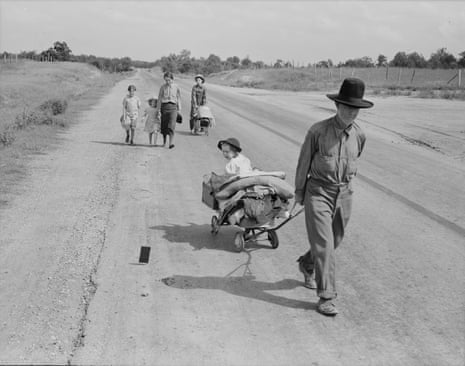“The camera,” Dorothea Lange once said, “is an instrument that teaches people to see without a camera.” Her portrait of Florence Owens Thompson, now universally known as Migrant Mother, provided powerful evidence that this was indeed the case. Taken in a camp for destitute migrant workers in California in 1936, while Lange was documenting the plight of the dispossessed during the Great Depression for the Farm Security Administration (FSA), the portrait is a study of a mother’s anxiety. When it was published in the press, it precipitated a generous flow of government aid to the Californian work camps.
Migrant Mother has become perhaps the most famous American photograph of the past century. It haunted Thompson, who later tried to prevent its reproduction and, in 1978, told a journalist: “I wish she had never taken my picture. I can’t get a penny out of it. She didn’t ask my name.” Ironically, Lange had been instructed to ensure the anonymity of her subjects in guidelines laid down by the FSA. The portrait is given a room of its own in this extensive retrospective, with five alternative versions on display, including one of the few surviving early prints in which Thompson’s thumb is visible in the bottom-right corner, clasping a tent pole. For some reason, the thumb bothered Lange so much that she rendered it as a blurred presence in later prints.
Lange’s meticulous approach and compositional skill are evident throughout this exhaustive show, matched by her seemingly instinctive ability to home in on people whose faces, gestures and silhouettes are emblematic of the economic and political forces shaping their lives. If the Great Depression was the defining event of her creative life, and the images she made on the streets of the US in the 1930s remain her most celebrated work, this chronological exhibition traces the arc of a much longer creative journey that spanned the ensuing decades until her death in 1965.
There are 15 series of works on display, from Lange’s early studio portraits of friends and fellow artists to the photographs she made of the west of Ireland and its people in the mid-1950s. The Great Depression, she said, “woke me up”, and her political awakening was matched by a creative shift towards more expressive portraiture.
Her less familiar studies of the poor and dispossessed often evince a melancholy beauty: a young female migrant worker, a makeshift cotton scarf shielding her face from the sun, gazes stoically at the camera as if surrendering to it. An older woman is caught from below, gaunt and erect in stained labourer’s clothes, against an unforgiving sky. Often, Lange’s images manage to be both intimate and epic, the sense of individual isolation she captures evoking the collective experience of countless migrant workers, uprooted from their homes and forced to work long hours for pitiful wages in the promised land of the American west. For me, this ability to distil the plight of vast numbers of people into a single image is Lange’s defining gift as an image-maker.

One of her series, Japanese American Internment, has an added resonance given what is happening to migrant parents and children in the US right now. Made in the wake of the attack on Pearl Harbor, it documents the fate of the 120,000 US citizens with Japanese ancestry who were rounded up and relocated to makeshift prison camps for the duration of the war. Though hired by the War Location Authority, there is nothing neutral about Lange’s gaze, which explains why most of the photographs remained unseen for decades. “They wanted a record,” she said, “but not a public record.”
Lange remained a socially engaged photographer throughout her life, never quite reinventing herself in the restlessly creative way her contemporary Walker Evans did. Nevertheless, her gaze deepened and took on a more evocative aspect as she engaged with an everyday US defined by stark contradictions and casual injustices. Her Deep South series possesses a palpable, even poetic, sense of place, with certain images evincing an almost languorous feel even as they portray a society where segregation and exploitation have become institutionalised, and thus normalised. A 1936 group portrait entitled Plantation Overseer and His Field Hands, near Clarksdale, Mississippi, is a carefully composed tableau that implicitly portrays the deeply embedded racist power structures of the American south.
At one point, Lange, like Evans, became fascinated by the vernacular architecture of the south, the timber churches, silos and shopfronts, which she shot with uncharacteristic detachment. Simultaneously, she began cropping her portraits to isolate hands, torsos and the texture of fabric and material worn and frayed by toil. The curators make a tenuous connection between the geometry of these arresting closeups and the childhood polio that left Lange lame, but they seem more indicative of her determination to transcend the traditional documentary work that had defined her. Caught on film, in old age, she speaks with extraordinary insight about her work and photography in general, which she defines as “a peculiar and powerful instrument for saying to the world: this is how it is”. Politics of Seeing is a monumental, sometimes surprising, retrospective that traces the full arc of Lange’s sustained creative life. For anyone even remotely interested in the history of photography, it is a must-see show.

In 2014, when the Fundación Mapfre gallery in Madrid hosted a survey show of Vanessa Winship’s work, I ended my review with the words: “One wonders when a British gallery will acknowledge her in a similar way.” The Barbican has finally obliged, devoting the upstairs gallery to an artist who has quietly established herself as a singular presence in contemporary documentary photography.
From the start, Winship has drawn on literary as well as photographic influences – the Albanian novelist Ismail Kadare was an early touchstone. Her observant eye has been drawn to people and places on the periphery, whether in the Balkans, where Europe’s edges blur, or in the vast US heartlands where identity is often defined in terms of the local rather than the national.
In 2011, she published Sweet Nothings, a beautiful, small edition photo-book of portraits of east Anatolian schoolgirls. Printed much larger for this show, the images still cast a spell – the girls posing tentatively in rural classrooms and on barren hillsides, their faded blue uniforms trimmed with lace collars on which mysterious words, the “sweet nothings” of the title, have been embroidered. Elsewhere, Winship engages with the dilemmas of belonging, exile and memory. She is a photographer who is at home in the hinterlands, where people, places, countries and continents merge, even as the national borders that separate them hove into view. Her series Black Sea is subtitled Between Chronicle and Fiction, which goes some way towards evoking the atmosphere of her work and her approach – a kind of imaginative social documentary that is both rooted in place, yet elusive.

In her critically acclaimed US series, She Dances on Jackson, her subjects often appear perfectly relaxed in the presence of her camera, and yet preoccupied or detached. In her quiet way, Winship evoked the US’s declining industrial cities and the vast empty spaces between them. Already, these photographs seem almost elegiac in their evocation of a suddenly distant US, pre-Trump and the rise of the “alt-right”: an uncertain America before the fall.
The exhibition culminates with the new body of work that gives it its title: And Time Folds is arresting in its difference, a constellation of images that attempt to show the world as seen though her granddaughter’s eyes. In this democratic child’s eye view, things are given equal meaning, whether shot on a mobile phone or a film camera. Everything is somehow related – a cake, leaves on a tree, a butterfly, the moon, a panoramic shot of ancient ruins and a collection of bird’s eggs – though the personal associations that underpin their selection remain mysterious. It is a bold and unexpected, if not wholly satisfying, ending, which may signal a shift away from poetic documentary towards conceptualism. Whatever, it is an interesting way to subvert the very notion of a retrospective: what follows is what counts.
- Dorothea Lange: Politics of Seeing and Vanessa Winship: And Time Folds are at the Barbican, London, from 22 June to 2 September.

Comments (…)
Sign in or create your Guardian account to join the discussion